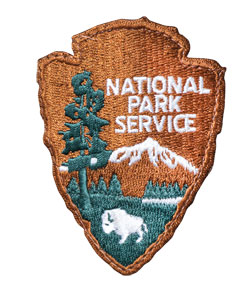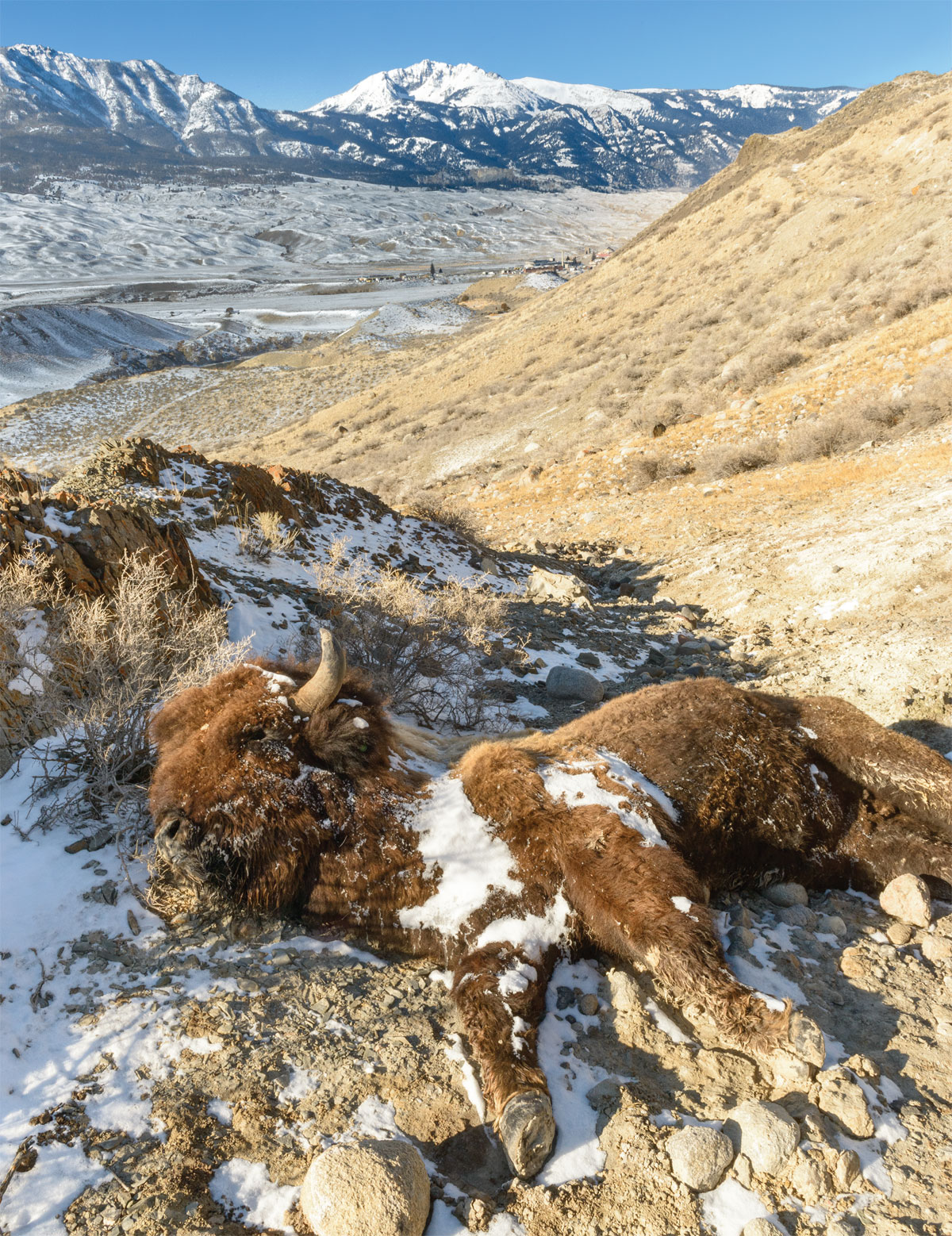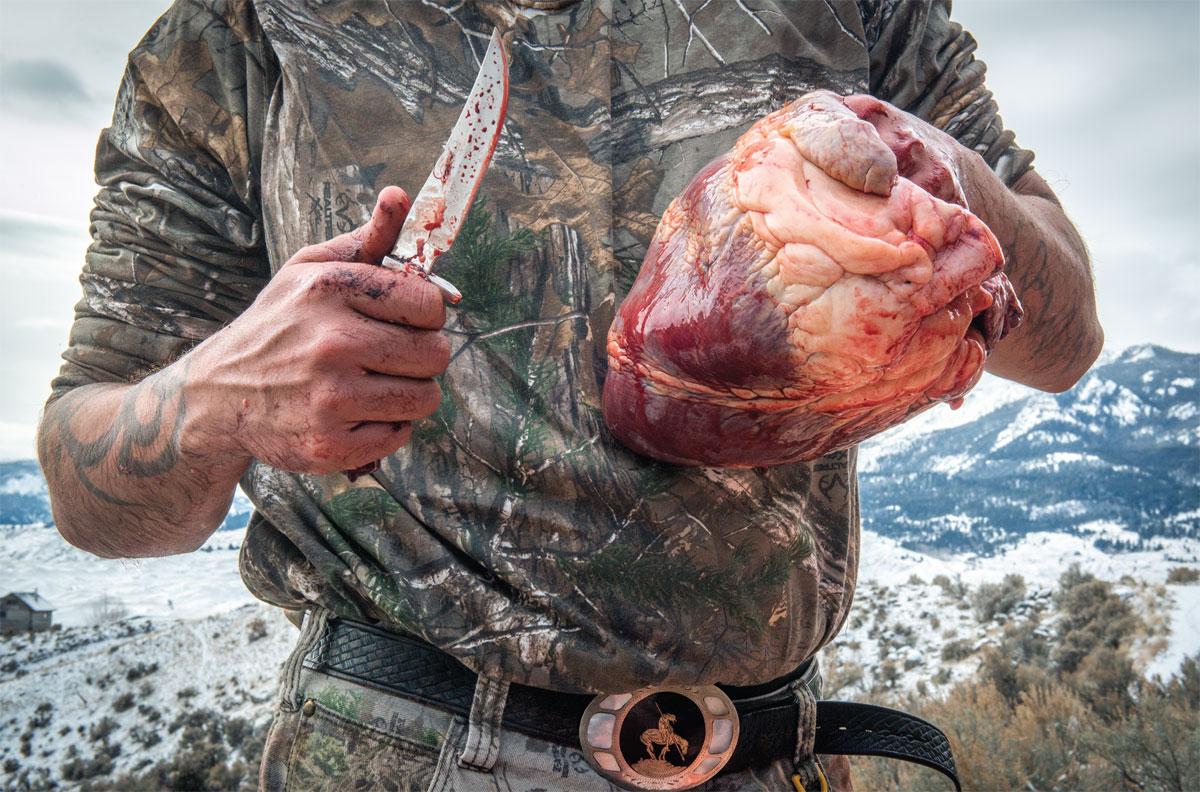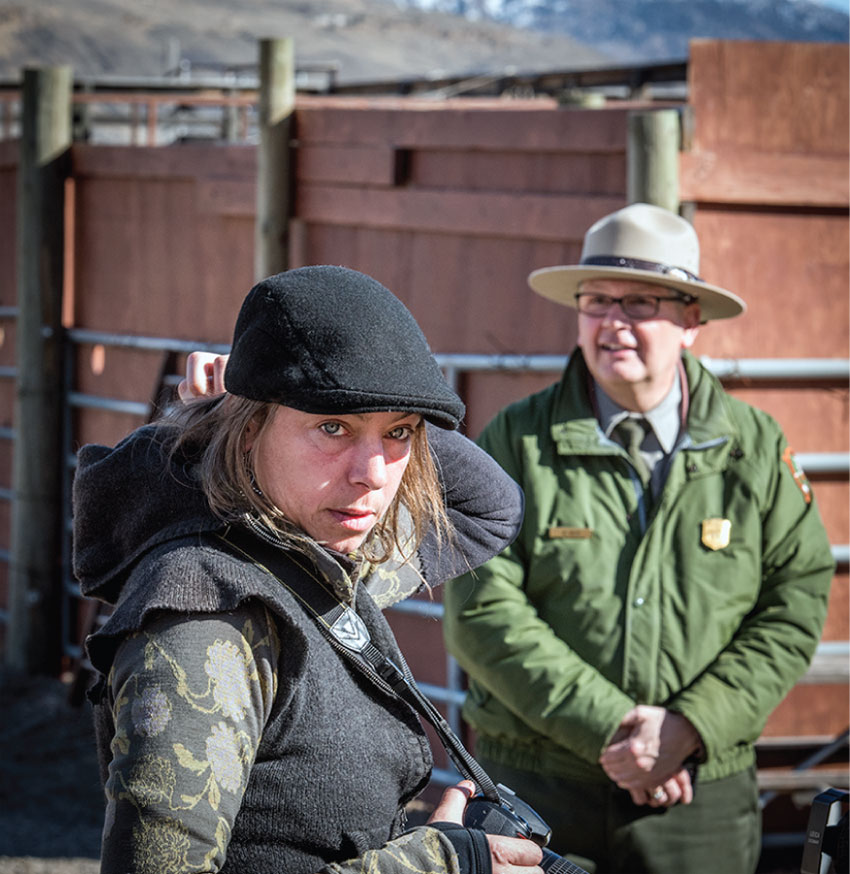This article appears in the May Issue of VICE Magazine.On February 6, lawyers at the American Civil Liberties Union, representing me and a conservation nonprofit in Montana called the Buffalo Field Campaign, filed a letter of intent to sue the National Park Service. The letter stated that the agency, which manages some of the country's most majestic public lands, had violated the First Amendment by barring citizens from access to its "Bison Cull Activity" in Yellowstone National Park. Every year, Park Service officials capture and slaughter hundreds of wild bison, but for more than a decade they have refused to allow these activities—conducted on public land by public officials with taxpayer money—to be viewed or documented. "The public," said the ACLU, "has a strong interest in knowing what the government is doing."
Advertisement
I once saw a video of bison being trapped in preparation for their sorting and slaughter. It had been filmed in 2004, in Yellowstone, the last year the Park Service permitted viewing of their bison operations. In the video, the bison are angry, bucking and kicking. The wranglers cry, " Hyah, hooee, yah yah, uhsh uhsh," smiling as they whip and beat the animals from catwalks. The camera angle shifts to the colliding bodies of the creatures, which cram in the bottleneck of the chutes. They climb over one another like worms in a bucket. Then the wranglers shove hooks into the noses of the bison. The animals' heads are forced up, their eyes bulging, bloodshot, and you can hear them wheezing and panting, and you can see the fury in their gaze. A needle is jammed into their necks to test for disease. I'd also seen video of other acts perpetrated on the bison: officials from the US Department of Agriculture's Animal and Plant Health Inspection Service, for example, shoving dildos into the asses of bull bison to make them ejaculate, so they could collect semen samples.Seventy-four percent of Americans, according to a 2008 poll by the Wildlife Conservation Society, believe that bison are "extremely important living symbols of the American West." The WCS itself has stated, "It would be hard to think of a mammal more symbolic of our nation." The 2013 National Bison Legacy Act, awaiting action in Congress, would adopt the bison "as the national mammal of the United States." The image of Bison bison, colloquially called the buffalo, sits on our coinage—recall the famous Buffalo nickel. It's in our folk songs: "Oh, give me a home where the buffalo roam" goes "Home on the Range," the unofficial anthem of the American West. Eighteen states have a town or city named Buffalo; the one in New York was christened for the abundance of bison found in the 1700s at a nearby creek. The bison is the official state mammal of Oklahoma, Kansas, and Wyoming, and it figures on the state seal of Indiana. The National Park Service celebrates the species with the emblazoning of a bull bison on its logo.
Advertisement
Given that our forebears slaughtered buffalo during the 19th century in a kind of wildlife holocaust, this all-American iconography is perverse and somewhat depressing. Perhaps it's an expression of a deep national guilt, an attempt to expiate an original sin. There were once so many buffalo in this country—they numbered, by some estimates, as many as 60 million—that a single herd on the High Plains could be seen for a hundred miles. "Of all the quadrupeds that have lived upon the earth, probably no other species has ever marshaled such innumerable hosts," conservationist William T. Hornaday wrote in his classic 1889 monograph The Extermination of the American Bison. "It would have been as easy to count [the] number of leaves in a forest as to calculate the number of buffaloes." Bison were happiest on the grasses of the prairies and the plains, though they lived in almost every state in the lower 48, from Maine to Florida, from the eastern tidewater to the Rocky Mountains, from Texas to Montana. As measured by biomass, they may have comprised the largest-ever concentration of an animal species on the planet.

Within a 50-year period, from roughly 1850 to 1900, they were all but wiped out. They were victims of the market forces unleashed by Euro-American settlement—"man's reckless greed," as Hornaday wrote, "his wanton destructiveness"—and their hides became prize commodities in eastern cities and in Europe. Hunters by the thousands, riding the newly built railways, obliged the demand with a ruthless campaign of plunder. Millions of bison that had grazed the plains and prairies and the high country were replaced with cows that henceforth had free access to the forage—a financial boon to the cattle industry. And there was an added political benefit, one that the US government noted in the drive toward Manifest Destiny and the settlement of the West: By annihilating the bison, the market hunters destroyed the commissary of the native Plains tribes, who remained independent and rebellious only so long as they had an ample supply of bison for food, fuel, and clothing.
Advertisement
By 1900, wild bison in North America had dwindled to just 23 animals holed up in Yellowstone National Park, where they were protected from hunters. The Yellowstone bison, listed as "threatened with near extinction" by the International Union for Conservation of Nature, have recovered in recent years to as many as 5,000 animals. They have never been domesticated, never been fenced in or interbred with cattle. They are genetically pure, behaviorally wild, surviving as their ancestors did, battling snow, ice, predation, and starvation. They are the last of their kind, the only remaining link to the herds that roamed this country for more than 11,000 years.Last February, a week after the ACLU filed its letter, I stood at dawn on a dirt road near Yellowstone, listening to the sound of bison that had been corralled. There were the moans of bulls and cows, the calling of the calves for their mothers, the cracking of the wranglers' whips, the cruel voices of men, and the crashing of the creatures' huge bodies against metal chutes. Through a spotting scope I could see, one and a half miles distant in the lowest reaches of the valley where I stood, a labyrinthine structure of steel and wood, the Stephens Creek Trap, from which the sounds reverberated. The animals had been wrangled off the landscape and chased by men on horseback into this labyrinth. I could discern through the scope, though barely, that several dozen bison were in the process of being sorted in the trap, some of them to be trucked to slaughterhouses.
Advertisement
The goal of the ACLU lawsuit was to see, smell, and hear, up close, bison corralled, beaten, whipped, raped, sorted, and moved onto the trucks that carry them to their death. The Park Service bars the viewing of these activities out of an ostensible concern "for the safety and welfare of the public, staff, and bison." I think the real concern is that the public, if it knew what was being done to the Yellowstone herd, might demand a change in policy.

Among the missions of the National Park Service is not only to protect public lands but also "to preserve native wildlife species and the processes that sustain them." The reason this mission is ignored in the case of bison depends on who does the reasoning.When I visited Yellowstone in February, the park's chief of public affairs, Al Nash, handed me a fact sheet asserting that the bison carry a disease called brucellosis, which, if spread to cows, could be devastating to the local cattle industry. Brucella abortus cycles harmlessly in bison, but it causes female cows to abort their calves. Cattlemen, understandably, have expressed horror at this prospect, denouncing bison as "diseased." When the animals breach the park's boundaries—as is their wont, roaming at will, caring not for artificial lines on a map—they are said to be a threat because they might spread brucellosis to cattle that graze on the national forest bordering the park in Montana.
Advertisement
Munchies: Ice Fishing Is Amazing, If You Can Stand the FrostbiteThe Montana Department of Livestock (DOL), which oversees the state's cattle industry, sued the Park Service in 1995 to implement the control of bison that stray out of Yellowstone. The US District Court of Montana, in 2000, decided in favor of the DOL, establishing what became known as the Interagency Bison Management Plan (IBMP), still in effect today. Prior to 2000, the DOL had been conducting the slaughter of roaming bison. The IBMP effectively subordinated the Park Service to the demands of Montana ranchers, requiring the agency, in cooperation with the DOL, to quarantine bison that cross into the state, test them for brucellosis, and, in some cases, kill them. The cost of the plan totaled as much as $3.3 million a year—an estimated $50 million since its enactment 15 years ago. Ninety-five percent of the money has come from federal funding.
Critics of the IBMP call it a politically corrupt scheme that fails to address the scientific facts of brucellosis. A 2009 study by the Journal of Applied Ecology found that not a single instance of brucellosis transmission from wild bison to cows has ever been documented. The US Government Accountability Office found in 1992 that the risk of transmission approaches zero. Paul Nicoletti, a veterinarian and animal epidemiologist at the US Department of Agriculture, told a documentarian for the Buffalo Field Campaign that "the threat doesn't seem to be there." When pressed, even the Park Service admitted, in a statement to VICE, "There is recognition by both disease regulators and wildlife managers that the risk of brucellosis transmission from bison to cattle is minute.""The livestock industry in Montana has got such political clout that the Park Service ends up doing their dirty work." –James Bailey
Advertisement
Stephany Seay, media coordinator of the Buffalo Field Campaign, believes that the real story behind the IBMP is the capture of federal bison policy by a politically powerful interest group: the livestock industry. Bison wandering outside the park compete with cows for grass, and the stockmen, for obvious reasons, balk at the competition. Mary Meagher, a retired Park Service biologist who studied bison in Yellowstone for 37 years, agrees with Seay's assessment. "Brucellosis is a smoke screen," she told me. "The likelihood of transmission is minimal. The real issue is that ranchers don't want bison out there on the land."Prior to the implementation of the IBMP, Park Service officials had spoken out freely against the slaughter of bison in Montana. John Varley, Yellowstone's research director, told author Doug Peacock, in a 1997 piece for Audubon magazine, that bison policy was "a struggle between the park and agribusiness, and we're losing badly." Yellowstone's superintendent at the time, Mike Finley, described the slaughter as "a national tragedy." He told Peacock, "We are participating in something that is totally unpalatable to the American people, and it's something we are not convinced that science justifies." No such language has been forthcoming from the current management at Yellowstone.Munchies: You've Got to Hunt for Your Own Steak in the Australian OutbackOf the estimated 5,000 bison in the park in February, only a few hundred had roamed into Montana, and most of these had already been killed. The goal during 2015 was to "cull," in the language of wildlife management, at least 900 of the creatures, almost 20 percent of the herd. Park Service officials told me that the IBMP had established a maximum population of 3,000 bison in the park, and that this year's cull was a first step toward achieving that number. James Bailey, a retired professor of wildlife biology at Colorado State University and author of the 2013 book American Plains Bison: Rewilding an Icon, told me the ceiling of 3,000 animals is "a political number, not a biological or ecological number. It's what the ranchers will accept.
Advertisement
"Bison are only a problem in the state of Montana," he said. "And the livestock industry in Montana has got such political clout that the Park Service ends up doing their dirty work."

On my second day in Yellowstone, I met up with six volunteers from the Buffalo Field Campaign who were working under the direction of Seay. The group awoke at dawn at a hostel off US Route 89, ten miles outside Yellowstone.In the hostel's commons, we breakfasted on a roadkill mule deer the group had found and cooked. Then, laden with two-way radios and spotting scopes and cameras, we drove to a high point off 89 to surveil the Stephens Creek Trap, where bison had been corralled all week long by DOL and Park Service wranglers, who were now preparing to send the animals to slaughter in the backs of 18-wheeler trucks.The sun topped the mountains, the light rolled across the valley, and a cold wind blew. Seay, a 44-year-old Montanan, had previously worked for the National Park Conservation Association but was laid off due to ideological differences (Seay claims she was "too radical"). She preferred the confrontational methods of the BFC. "We get in people's faces," Seay said. "It's not called a field campaign for nothing."BFC volunteers have collectively served many months of jail time for acts of civil disobedience—chaining themselves to fences, for example—and have been charged with crimes that include disorderly conduct, violation of "bison management closures," obstruction, and interference with government operations. The group has sued the US government and State of Montana to overturn the IBMP. It has petitioned the US Fish and Wildlife Service to list Bison bison under the protection of the Endangered Species Act. Its leadership, including Seay, has lobbied Congressmen and Montana state legislators. But the group's chief accomplishment, Seay said, is documentary videography. "We point our cameras at the Park Service and the DOL so that the public can see what's being done."
Advertisement
Seay trained our spotting scope on the trap and muttered at the distant ant-size shapes of the wranglers, who cracked their whips. The sound of the buffaloes' cries rose and fell on the shifting wind. We watched several dozen more animals stampeded into the trap by the ant-men, who were now mounted on ant-horses. Seay looked at her watch: 8 AM. Usually the trucks go out by this time to one of several slaughterhouses in Montana, each carrying as many as 60 bison overcrowded in stinking containers.The BFCers broke into two units, code-named Bighorn and Jackrabbit, the one to climb the hills over the valley for a better view of the trap, the other to follow the trucks north into Montana.I went with Jackrabbit, which consisted of Seay at the wheel of our car, a freckled 24-year-old volunteer from Connecticut named Heather Ashey, and my photographer, Michael Coles. "Jackrabbit," squawked the two-way radio that Heather held. "This is Bighorn, we're in place. The trailer is half full.""Well, they're gonna ship," nodded Seay.We could hear the distant metallic crashing of the animals in the trap, and the deeper booming of their bodies against the walls of the trailer where they were loaded."Jackrabbit, truck is pulling out. They're running a nice little convoy.""Convoy?" asked Coles. "What for?" I spied in my field glasses three cars in front of the tractor trailer, and three behind, and was surprised to see they were law enforcement vehicles, full of armed men from the Montana DOL; Montana Fish, Wildlife, and Parks; Montana State Troopers; and National Park Service.
Advertisement
"It's to make sure the buffalo are safely sent to be killed," Seay said acidly.We let the convoy pass on US 89, Seay pulled out behind it, and immediately the trail car, a state trooper, braked and forced us back. "He's trying to put space between us and the buffalo," she said.At the intersection of US 89 and Interstate 90, the convoy turned east. "Probably toward the slaughterhouse in Big Timber," Seay said. Big Timber was a town 36 miles away.Related: I Hunted Feral Hogs in Florida as a Favor to the WorldWe pretended to veer off. The state trooper saw this and pulled to the side of the road. Seay careened past him as he was taking a piss and, flooring the gas on the interstate, cut off the DOL convoyman in his pickup. He didn't see us coming. As we waved and smiled, he snatched his radio from the dashboard and keyed the mic and looked like he was shouting.We were now directly behind the buffalo trailer, from which tufts of chocolate-brown hair flew in volleys. "The buffalo are freaking out and shedding," Seay said. We could see the animals crammed together; they tend to gore one another when unnaturally crowded.The DOL man pulled into the passing lane and tried to cut us off. Seay wouldn't let him. She smiled. "DOL hasn't had to deal with us pulling this shit in a long while—getting this fucking close to a slaughter truck."The truck swerved, and I imagined one of the bison had broken free and taken the wheel. Heather suddenly cried, "I have to piss!" She said she'd been clamping her bladder in silence for the past hour. Seay groaned. "You can't hold it?" In a testament to her dedication, Heather dropped her pants and let loose in a glass jar in the backseat. There was a round of applause in the car.
Advertisement
Just then the state trooper who had been caught with his cock in his hands edged in behind the DOL pickup, and we were nervous he would stop us. But he did nothing but shoot ugly glances. Coles took his photo.The mountains dwindled, and the highway, tracing the passage of the Yellowstone River, carried us into the spectacular prairie of eastern Montana, prime buffalo habitat, where in the 1880s a buffalo hunter named Vic Smith reported 10,000 of the animals gathered in a single herd. It depressed me that the only remnant was the wretched brown hair that flew from the trailer.When the convoy passed Big Timber, the town where we had thought the bison were being taken, Seay mulled over our options. She knew from having tracked slaughter trucks in the past that the convoy was headed to one of two facilities more than a hundred miles away. "Too far," she said. "We don't know which one. And we'll lose them if we stop for gas, which we're gonna have to."With a curse she broke off pursuit. At the highway exit where we turned around, a sign beckoned tourists to visit a vestigial colony of native prairie dogs, which, like the bison, had at one time been innumerable in the West. There were as many as 6 billion prairie dogs before the arrival of the white man. The prairie dogs had been poisoned, shot, suffocated, and set on fire to make way for Euro-American civilization. They were hated by ranchers—still are hated—because the little rodents eat grass. Less than 2 percent of their original populations remain. The sign looked to me like a grave marker for the West that once was.
Advertisement

That same day, February 18, the National Park Service had scheduled a public tour of the Stephens Creek Trap. Seay did not think it was a random event. The tour was announced exactly one week after the ACLU filed its letter of intent to sue. "BFC has asked and asked for access this year, but nothing happened," Seay said. "Then the Park Service gets that letter, and boom, there's a tour."It was a warm day, under a shining sun. Our guide, Yellowstone public relations director Al Nash, was fat and genial. (I assumed he hadn't heard about our car hijinks.) "We're going to give you an opportunity," he said with satisfaction, "to see and find out what happens down there." He introduced us to a wispy, smiling woman named Jody Lyle, the director of strategic communications, who strategically said nothing during the course of the hour that Nash had given us. Four armed men from the Park Service's law enforcement division made sure there was no trouble.We were allowed on the catwalks under the watchful eye of the cops. Bison that had already been sorted by size and sex stood pacing nervously in separate pens. Fur was everywhere, shed in clumps, the telltale sign of distress. In one pen were the calves, in another the younger cows, in another the bulls, and in yet another the mature cows.I asked the operations director of the trap, a fit and handsome park ranger named Brian Helms, whether we would see it in action—the corralling, the sorting, the beatings, the whippings, the testing for brucellosis with needles, the dildoing of the bulls for their semen. He stared at me behind dark sunglasses. "This is what you're allowed to see," Helms said."I guess we'll see you in court," I told Helms.From one of the pens came a low moaning. Seay looked sick. "You hear them?" she said. "The calves. Wanting their mothers. Bison live in family groups. They're like us—so much like us. Imagine your children penned like this. And who knows which of these calves' mothers was already shipped? The families broken up, their ties shattered. Look at the cows, the mothers, the way they pace. And look at these people"—she indicated Nash, Lyle, Helms, and the men with the guns—"look at how they don't understand. They think I'm crazy. I think they're the fucking lunatics."

The next day, Seay and I got on the phone with the ACLU to report on what she called "the insulting deception" of the tour. "It was a whitewash," Seay said. The lawyers agreed. The lawsuit is expected to be filed this month in the US District Court of Montana.One day at the end of February I drove with Seay into the park to do a bison count in the Lamar Valley and the Blacktail Plateau, where the herd was leisurely making its way to better grazing in the lower elevations of Montana. It was brutally cold, the sun frozen behind a wintry haze, and the wind blew hard. The bison enjoyed themselves not far from the road, nipping at grass through the snow. A big bull, perhaps 2,000 pounds, stopped at our approach, holding his massive head high. A cow came to his side and nuzzled him, their horns gently scraped, and the calves around them played games of what looked like tag. But the bull did not move and eyed us for a long while, until we got back in the car. We counted 200 animals, and Seay, with sadness in her voice, remarked they were all slowly advancing north, toward Montana, driven by the ancient migratory instinct, headed for destruction.Read more from Chris Ketcham.
